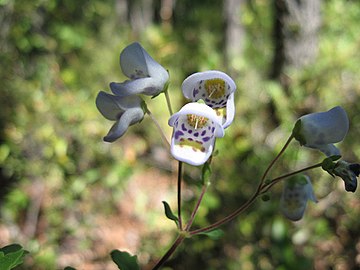
The order Lamiales are an order in the asterid group of dicotyledonous flowering plants. It includes about 23,810 species, 1,059 genera, and is divided into about 25 families. These families include Acanthaceae, Bignoniaceae, Byblidaceae, Calceolariaceae, Carlemanniaceae, Gesneriaceae, Lamiaceae, Lentibulariaceae, Linderniaceae, Martyniaceae, Mazaceae, Oleaceae, Orobanchaceae, Paulowniaceae, Pedaliaceae, Peltantheraceae, Phrymaceae, Plantaginaceae, Plocospermataceae, Schlegeliaceae, Scrophulariaceae, Stilbaceae, Tetrachondraceae, Thomandersiaceae, Verbenaceae.

Gesneriaceae, the gesneriad family, is a family of flowering plants consisting of about 152 genera and ca. 3,540 species in the tropics and subtropics of the Old World and the New World, with a very small number extending to temperate areas. Many species have colorful and showy flowers and are cultivated as ornamental plants.

Monarda is a genus of flowering plants in the mint family, Lamiaceae. The genus is endemic to North America. Common names include bergamot, bee balm, horsemint, and oswego tea, the first being inspired by the fragrance of the leaves, which is reminiscent of bergamot orange. The genus was named for the Spanish botanist Nicolás Monardes, who wrote a book in 1574 describing plants of the New World.

Phrymaceae, also known as the lopseed family, is a small family of flowering plants in the order Lamiales. It has a nearly cosmopolitan distribution, but is concentrated in two centers of diversity, one in Australia, the other in western North America. Members of this family occur in diverse habitats, including deserts, river banks and mountains.
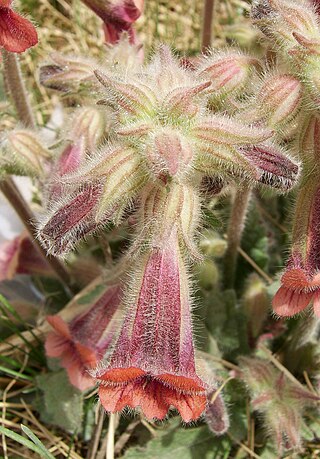
Rehmannia is a genus of seven species of flowering plants in the order Lamiales and family Orobanchaceae, endemic to China. It has been placed as the only member of the monotypic tribe Rehmannieae, but molecular phylogenetic studies suggest that it forms a clade with Triaenophora. Contrary to the immense majority of the taxa of Orobanchaceae, Rehmannia is not parasitic.

Calceolariaceae is a family of flowering plants in the order Lamiales that has been recently segregated from Scrophulariaceae. The family includes three genera, Calceolaria, Porodittia, and Jovellana, but analysis suggests that the monotypic Porodittia should be placed within Calceolaria. Recent molecular phylogenies that included Calceolaria have shown not only that this genus does not belong in Scrophulariaceae but also that it is the sister clade to the majority of the other families of the Lamiales. Morphological and chemical characters also support the separation of Calceolariaceae from Scrophulariaceae and other Lamiales. Some recent studies have supported a sister-group relationship between Calceolariaceae and Gesneriaceae. Given this close relationship, some authors opt to merge this family into Gesneriaceae as subfamily Calceolarioideae

Lophospermum is a genus of herbaceous perennial climbers or scramblers, native to mountainous regions of Mexico and Guatemala. Those that climb use twining leaf stalks. Their flowers are tubular, in shades of red, violet and purple, the larger flowers being pollinated by hummingbirds. Now placed in the greatly expanded family Plantaginaceae, the genus was traditionally placed in the Scrophulariaceae. The close relationship with some other genera, particularly Maurandya and Rhodochiton, has led to confusion over the names of some species.

Gypsophila repens, the alpine gypsophila or creeping baby's breath, is a species of flowering plant in the family Caryophyllaceae, native to the mountains of central and southern Europe, where it grows on dry, chalky slopes. The Latin name literally means "creeping chalk-lover". It is a prostrate, mat-forming herbaceous perennial, growing around 20 cm (8 in) tall by 30–50 cm (12–20 in) wide. For much of the summer it bears masses of star-shaped flowers which may be white, lilac or light purple, in loose panicles.
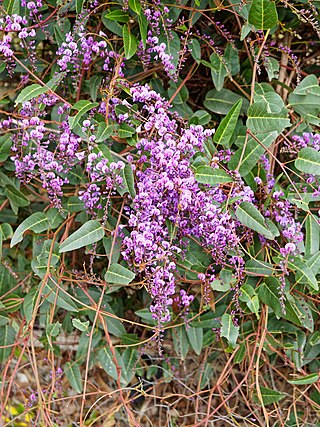
Hardenbergia violacea is a species of flowering plant in the family Fabaceae and is endemic to Australia. It is known in Australia by the common names false sarsaparilla, purple coral pea, and waraburra. Elsewhere it is also called purple twining-pea, vine-lilac, and wild sarsaparilla. It is a prostrate or climbing subshrub with egg-shaped to narrow lance-shaped leaves and racemes of mostly purple flowers.
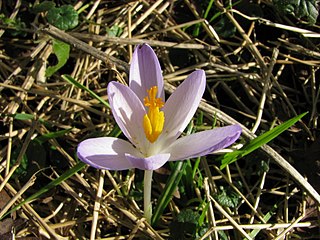
Crocus tommasinianus, the woodland crocus, early crocus, or Tommasini's crocus, is a flower named after the botanist Muzio G. Spirito de Tommasini (1794-1879). It is native to Bulgaria, Hungary, Albania, and the former Yugoslavia. It is often referred to as the early or snow crocus, but these terms are shared with several other species, although C. tommasinianus is amongst the first to bloom. Multiple plants are often called tommies in the horticultural trade.

Tecophilaea cyanocrocus, the Chilean blue crocus, is a flowering perennial plant that is native to Chile, growing at 2,000 to 3,000 m elevation on dry, stony slopes in the Andes mountains. Although it had survived in cultivation due to its use as a greenhouse and landscape plant, it was believed to be extinct in the wild due to overcollecting, overgrazing, and general destruction of habitat, until it was rediscovered in 2001.
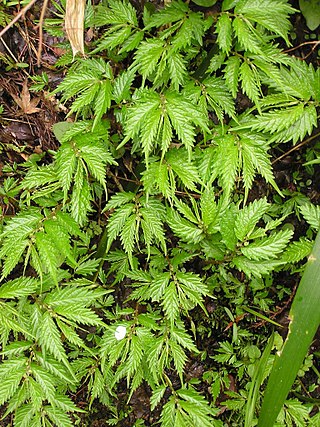
Elatostema is a genus of flowering plants containing approximately 350 known species in the nettle family Urticaceae, native to tropical forest clearings throughout Australasia, Asia and Africa. There may be as many as 1,000 species of this little-known genus, which is susceptible to deforestation and other forms of human exploitation. Some species, for instance the recently discovered E. fengshanense, show unusual adaptations to growing in deep shade in caves. DNA analysis suggests that the three genera Elastostema, Pellionia, and Pilea be grouped together as one.

Eremophila polyclada, commonly known as twiggy emu-bush, flowering lignum, lignum fuchsia and desert lignum is a plant in the figwort family Scrophulariaceae and is endemic to Australia. It is a dense, spreading shrub with narrow leaves and white to pale lilac-coloured, purple-spotted flowers. It occurs in all mainland states except Western Australia.

Passiflora × violacea, the violet passion flower, is a hybrid between two species of flowering plants, Passiflora racemosa × Passiflora caerulea, in the family Passifloraceae. The name Passiflora × violacea has yet to be resolved as a correct scientific name; nevertheless it is widely found in the horticultural literature.

Jovellana violacea, also known as the violet teacup flower or violet slipper flower, is a perennial species of flowering plant in the family Calceolariaceae. It is native to Chile.

Jovellana punctata, or the teacup flower, is a perennial species of flowering plant in the family Calceolariaceae. It is native to central Chile.
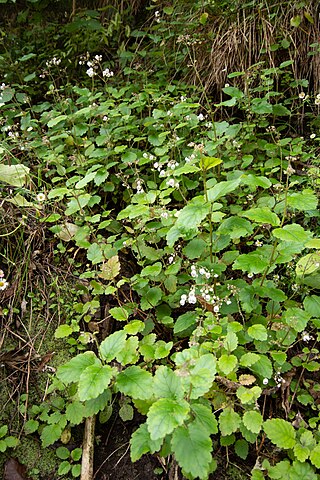
Jovellana sinclairii, commonly known as the New Zealand calceolaria, is an endemic New Zealand shrub found in eastern and central North Island forests. In the family Calceolariaceae, it has white, bell shaped flowers with spots of purple on the inside.

Jovellana repens is an endemic New Zealand plant in the family Calceolariaceae spread through both the North and South Islands. It has small green leaves and white flowers with spots of purple on the inside.
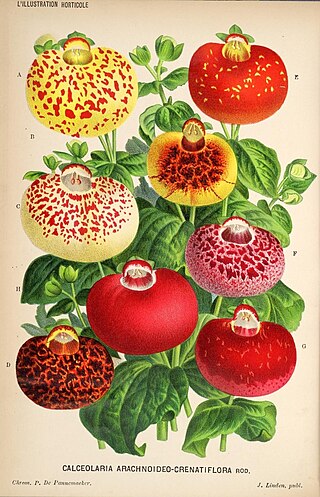
Calceolaria crenatiflora is a species of flowering plant in the pocketbook plant genus Calceolaria, family Calceolariaceae. It is native to central and southern Chile and southern Argentina. It has gained the Royal Horticultural Society's Award of Garden Merit as a warm temperate greenhouse ornamental. Along with Calceolaria corymbosa and Calceolaria cana it has contributed to the Calceolaria Herbeohybrida Group of cultivars.

